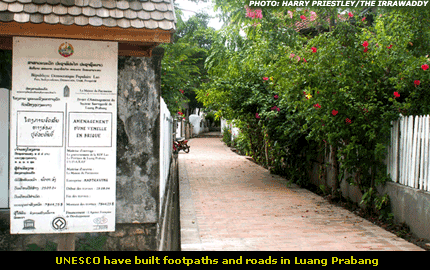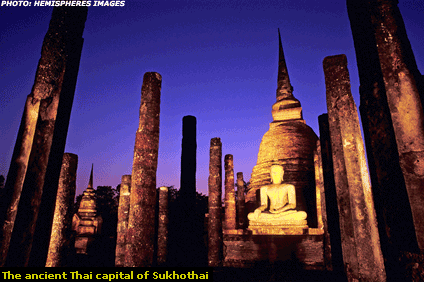
| By HARRY PRIESTLEY/LUANG PRABANG | JUNE, 2005 - VOLUME 13 NO.6 |
Burma’s ancient capital of Pagan is shaping up to be an eyesore while the former Lao royal capital of Luang Prabang strives to preserve its ancient monuments.
 What a contrast between two ancient capitals, both redolent of distinct, historic cultures. One, Burma’s former capital Pagan, is moving towards what promises to be an ugly future motivated more by commercial interests than a desire to preserve the past; the other, Laos’s old royal capital of Luang Prabang, is trying to keep as much as possible of its traditional appeal intact.
What a contrast between two ancient capitals, both redolent of distinct, historic cultures. One, Burma’s former capital Pagan, is moving towards what promises to be an ugly future motivated more by commercial interests than a desire to preserve the past; the other, Laos’s old royal capital of Luang Prabang, is trying to keep as much as possible of its traditional appeal intact.
The main difference in approach is that while the Lao Government has fully embraced the UN cultural agency UNESCO’s active guardianship of Luang Prabang as a World Heritage Site, the
The tower is really just the latest in a long line of developments in Pagan that have provoked outrage from international groups concerned about the site’s preservation. Other controversial projects include the 18-hole Bagan Golf Resort, which opened to the public in 1999, mere putting distance from the heart of the archaeological zone. In addition, a highway, constructed in the mid-1990s, cuts right through the site. While the generals who run the country might be rubbing their hands at the prospect of all those tourist dollars rolling in, the experts are pulling their hair out.

With reports of important murals being whitewashed at the behest of unimpressed generals and the constant “beautification” of structures using inappropriate modern materials like brick and cement, Pagan now finds itself in danger of turning into what UNESCO’s Christian Manhart has termed “a Disney-style fantasy version of one of the world’s great religious and historical sites.”
The UN agency carried out various projects at Pagan throughout the 1980s and early 1990s, focusing on the need to conserve masonry and murals, strengthen buildings against earthquakes, and train specialists. But when they presented a fully detailed report and site management plan to the Burmese government, they were reportedly greeted with silence. Refusing to sign the master plan for Pagan, the authorities proceeded to ignore completely the UNESCO recommendations and carry on with their own vision for the site.
In June, UNESCO’s regional advisor for culture, Richard Engelhardt, told the BBC that the site was “becoming less and less a real document of the glory of Pagan’s past and more an un-understandable book of nonsense,” while Pagan expert Pierre Pichard has gone on record as calling the much-publicized viewing tower “a cultural crime.”
 So, exasperated by years of trying to convince authorities to preserve rather than recreate, UNESCO decided enough was enough and pulled out of Pagan altogether. One implication of this is that Pagan will not now receive recognition as a World Heritage Site, as was expected as recently as 2002. One consultant, who preferred to remain anonymous, explained that “the problems in
So, exasperated by years of trying to convince authorities to preserve rather than recreate, UNESCO decided enough was enough and pulled out of Pagan altogether. One implication of this is that Pagan will not now receive recognition as a World Heritage Site, as was expected as recently as 2002. One consultant, who preferred to remain anonymous, explained that “the problems in
So how is a World Heritage Site managed?
A sleepy town on the confluence of the Mae Khan and Mekong rivers, Luang Prabang in northern
While it used to be the case that only ambitious travelers, or those in the know, made the arduous journey north from the capital Vientiane, Luang Prabang now bustles with practically every breed of holidaymaker, attracted largely to the town’s serene natural beauty and laid-back atmosphere.
A year after making the Heritage list in 1995, a French team arrived in Luang Prabang to set the site perimeter and compile an inventory of the town’s buildings. Upon completing their assessment, the team presented the Lao authorities with a finished report. Unlike the Burmese generals, however, the Lao government liked what they read and gave UNESCO the go-ahead to implement their plan, so establishing a partnership with the international body to oversee management of the site.

“We have two missions here,” explains Emmanuel Pouille, chief technical advisor at the Maison du Patrimoine, a former customs house which serves as UNESCO’s on-site base. “The first is to protect the heritage of Luang Prabang and the second is to provide public works: building roads and footpaths, setting up irrigation and drainage facilities and so on. But one of our most important duties is to work with the local authorities, helping them to understand the complex guidelines and regulations we have.”
Any proposed new building in the zoned area has to pass through the Maison du Patromoine before work can begin. Most applications are rejected on the grounds that the proposed structures are not in keeping with the style of surrounding architecture and scenery. As Pouille says, “[the town] is probably the only place in
On the other hand, if plans are submitted that do conform to the regulations, UNESCO almost fall over themselves to help, even providing traditional materials free of charge. “What we try to do is explain to people the value of keeping hold of their heritage. In ‘95 [when UNESCO first arrived], there was no terracotta production; all new construction was concrete and metal. We reopened the kilns and set up production programs. This way jobs are created and traditional skills and architecture are kept alive.”
UNESCO’s presence is apparent during even the briefest of strolls around the town’s protected peninsula. Large white information boards stand at the entrance to footpaths and temples detailing the work carried out by the group and, though an essentially quiet town, development is very much in the air.

Of course, development of any kind is never less than contentious. “The main street used to be the Chinese quarter,” says Sisivath Nhilatchay, director of the
The street in question, somewhat aptly named Sakkarine, is indeed something of a foreigner’s village. Caf?s serving baguettes and crepes jostle for prominence alongside internet shops and trekking companies, while in the evenings a night market emerges selling Beer Lao T-shirts and generic handicrafts aimed squarely at ambling tourists. At times, the only real clues that visitors are actually in
While many are cleaning up financially because of the exposure Luang Prabang has received since UNESCO and their millions arrived on the scene, not everyone is happy. “It’s true UNESCO have brought jobs and money to Luang Prabang,” says a local resident who preferred not to be named. “But they’re trying to recreate a Luang Prabang that never existed. They’re using locally made building materials that are poor quality and telling people—who are earning decent money for the first time in their lives—what they can and can’t do. They’re trying to make Luang Prabang into a quaint little theme park, and all the time it’s just developing into another backpacker hangout.”
It’s a point Pouille acknowledges, but challenges. “Local people equate timber with poverty—they see concrete as progress,” he says. “We understand the pitfalls of development with regard to the impact of tourism, but we are trying to slow the process. For example, many people are asking for permission to close off the stilted areas under their houses, to make more room for themselves because they can’t extend the actual buildings. We need to at least keep some examples of the traditional houses, though we can’t just let them disappear.”
And it’s the threat of things simply disappearing that brings us back to Pagan. While it’s evident that the involvement of UNESCO is a double edged sword, you can’t help feeling that their presence would be of enormous benefit to the Burmese site. It’s unthinkable, for instance, to imagine them agreeing to the painting over of ancient frescos, as is reportedly happening, or the redesign of unique religious monuments. And as for the concrete viewing tower? The reaction would be pretty easy to gauge there.
|
The Downside of World Heritage Status By Jim Andrews “World Heritage Site” status doesn’t necessarily open up big business opportunities for selected cities. For several years after its ancient ruins were designated a World Heritage site by UNESCO in 1991, Sukhothai, in central
By 2005, Sukhothai was attracting only half the number of tourists it had hoped for when drawing up its original projections. In the 12 months to May, 2005, less than half a million visitors passed through the gates of the At least one international travel guide book advised its readers heading for Sukhothai to book hotel accommodation in Phitsanulok, 60km away. Phitsanulok, travelers were told, offered a greater variety of comfortable accommodation and good restaurants. Phitsanulok’s enterprising city council, under a dynamic chief executive, took the initiative early on and launched an ambitious hotel building program. Sukhothai is catching up, but slowly. A new showpiece hotel incorporates a museum exhibiting fine examples of pottery and porcelain from the Sukhothai period, while the necessary funds were also found for a handsome new information center at the site of the old city. But an international travel writer who visited Sukhothai on a public holiday found the new center locked up and deserted. A Thai daily newspaper recommended the center for its toilets but nothing else. An attractive new airport was built outside Sukhothai with the intention of winning tourist trade. The airport is serviced by Bangkok Airways, which made it a vital element of an ill-fated project to cash in on the existence of several World Heritage sites within the The plan was to link four World Heritage sites in a network of air routes: the Mekong World Heritage Network. Launched in a blaze of publicity in 2001, the project never fully got off the ground. Bangkok Airways drew up a flight schedule linking Sukhothai with Luang Prabang, Sukhothai’s planned pivotal role in the scheme also looks decidedly shaky now. The Sukhothai-Luang Prabang flights have been dropped for the duration of the low season, although Bangkok Airways says they are expected to resume in October.
And are there contingency plans to include Pagan in any future expansion of the network? “Well, we do have regular flights from Bangkok to Rangoon,” was all Bangkok Airways' would say. |
